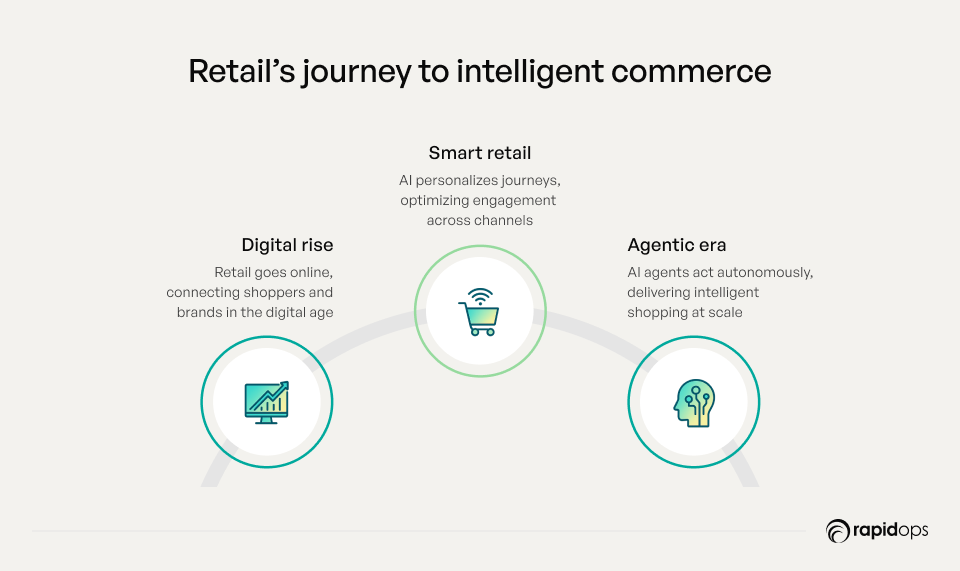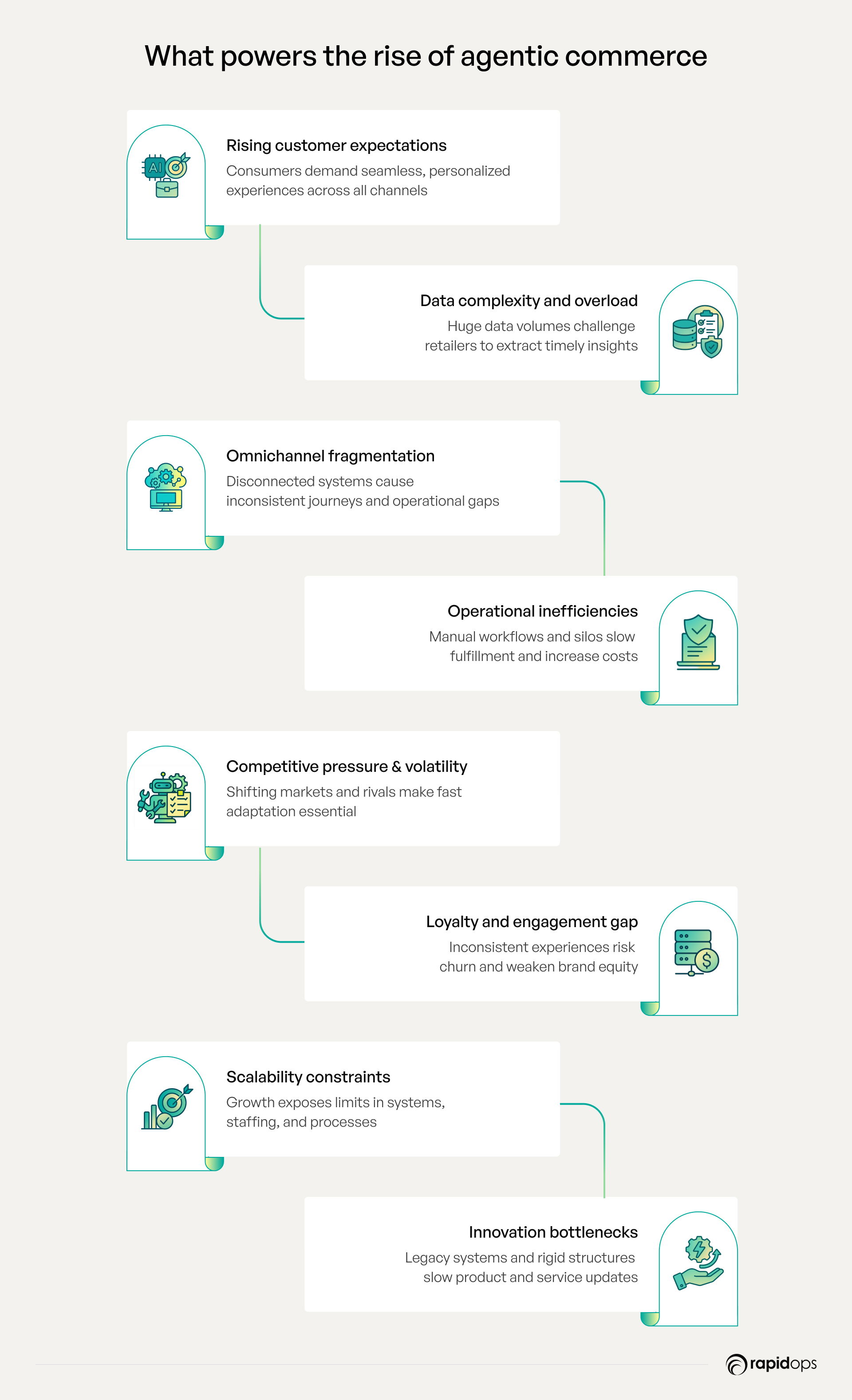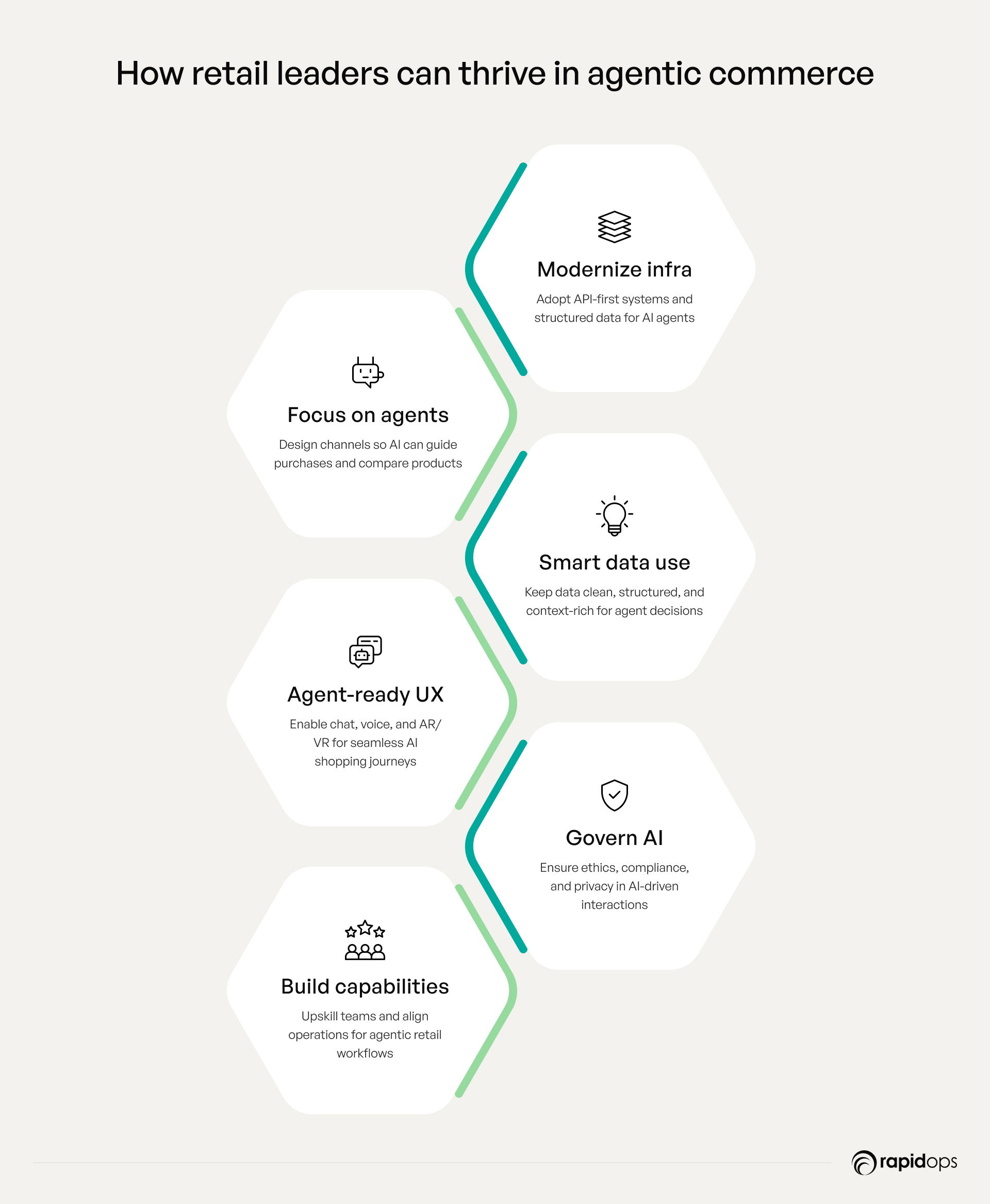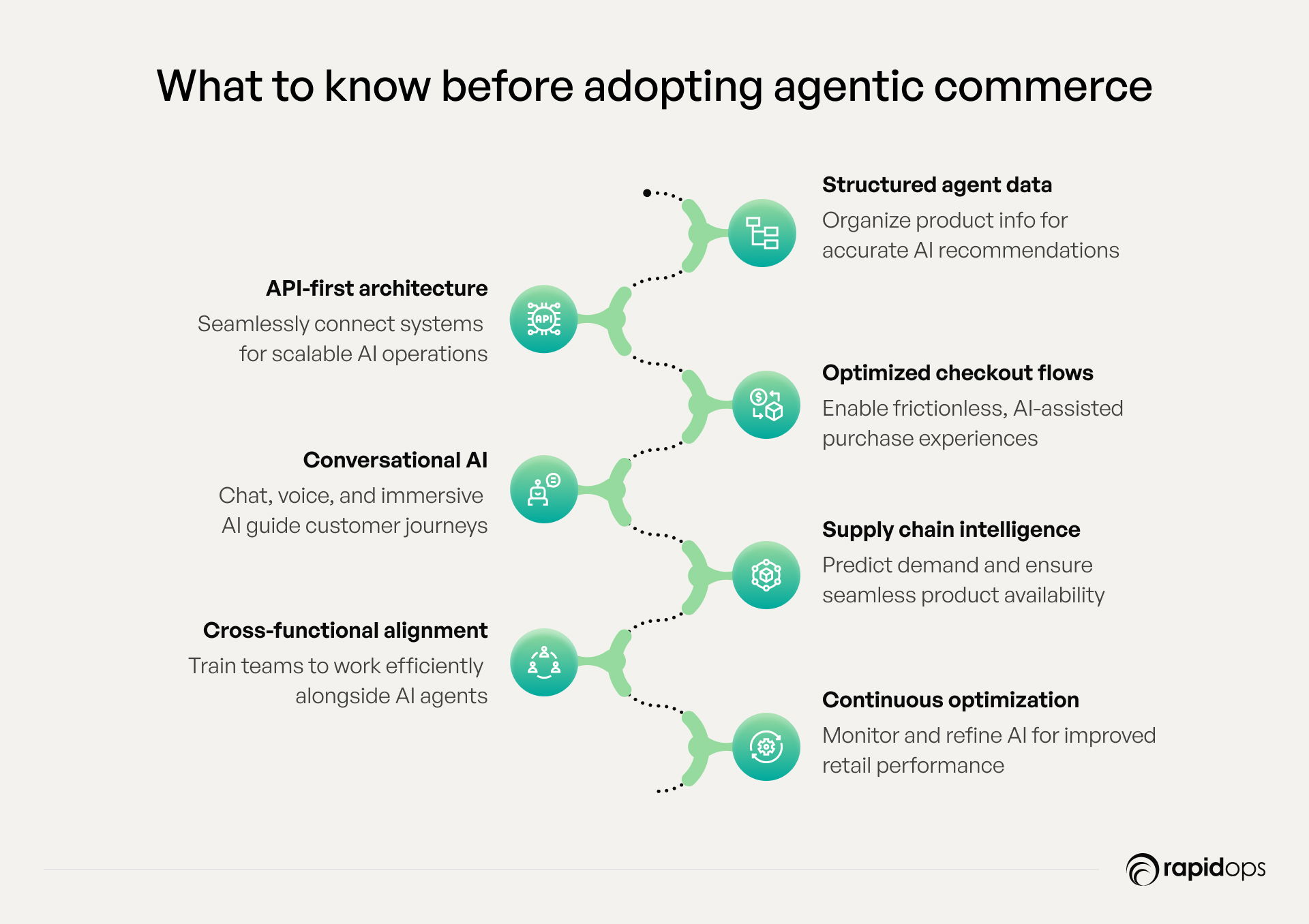Retail is one of the fastest-evolving industries across the global economy. Whatever technological breakthrough emerges, whether it’s the internet, mobile computing, or artificial intelligence, retail is almost always the first to feel its impact. The reason is simple yet profound: retail is the most customer-centric industry there is. It exists at the intersection where businesses meet real people with real needs, every single day.
And customers? They’re relentless in their pursuit of better experiences, faster service, more personalized interactions, and seamless convenience. This constant pressure from the customer side doesn’t just drive change, it demands it. Retailers have learned to adapt, evolve, and innovate faster than any other industry, because standing still is simply not an option.
Today, we’re standing at the edge of the next seismic shift in this ongoing evolution: Agentic Commerce. Powered by intelligent, autonomous AI agents, this new era goes beyond digital and data-driven retail, it introduces systems that can think, decide, and act independently. Agentic Commerce represents a transformation where technology doesn’t just support human decision-making; it collaborates, anticipates, and executes, redefining how customers shop and how businesses operate.
In the sections ahead, we’ll explore what’s driving this shift, how agentic commerce is reshaping retail transformation, and what retailers must do today to stay ahead of this intelligent, proactive future.
Understanding agentic commerce
Definition and core principles
Agentic commerce is a transformative approach in digital retail, where autonomous AI agents operate intelligently on behalf of consumers and businesses. These agents go beyond traditional decision-support tools, enabling autonomous decision-making, predictive engagement, and real-time action based on structured product data, purchase history, and continuously updated analytics.
At its core, agentic commerce relies on intelligent agents that learn continuously from interactions, allowing them to deliver personalized, proactive, and precise outcomes. These principles ensure that every interaction is informed, every recommendation is relevant, and every action aligns with business and customer goals.
By integrating these principles into retail systems, organizations can build self-optimizing ecosystems, streamline operations, enhance customer experiences, and maintain alignment with responsible AI practices.
In essence, agentic commerce transforms digital retail into an intelligent, data-driven environment where AI agents act strategically, consistently, and autonomously to create meaningful value for both businesses and consumers.
How it differs from traditional commerce
The distinction between conventional commerce models and agentic commerce is significant. While eCommerce primarily facilitates online shopping and omnichannel strategies integrate multiple touchpoints for convenience, agentic commerce introduces AI agents that act autonomously, transforming how consumers discover products, compare options, and complete purchases.
| Feature | eCommerce | Omnichannel | Agentic commerce |
| Customer interaction | Manual browsing | Multi-channel engagement | AI agents act autonomously |
| Decision support | Limited | Moderate | Full decision automation |
| Personalization | Basic | Medium | Dynamic, continuous, AI-driven |
| Purchase execution | User-driven | Assisted | AI-driven, instant checkout options |
| Operational role | Marketing & sales | Sales + service | AI agents optimize operations & customer journey |
| Data usage | Historical | Real-time | Predictive, structured, semantic |
Agentic systems reshape the dynamics of product discovery, evaluation, and purchasing decisions, offering retailers and consumers a level of intelligence, efficiency, and personalization that traditional models cannot achieve.
The retail context
Across today’s retail ecosystem, AI agents are emerging as intelligent intermediaries between consumers and products, transforming the way shopping experiences are delivered. Beyond enabling instant checkout, recommending products, and optimizing online interactions, these agents also provide post-purchase support, manage returns, oversee inventory, and streamline operational workflows.
By leveraging structured product attributes, purchase history, and real-time analytics, AI agents operate autonomously and proactively across the entire retail journey, creating seamless, personalized, and highly efficient experiences for both customers and businesses.
For retailers, agentic commerce introduces significant opportunities and strategic challenges:
- Visibility: Ensuring structured product data, accurate descriptions, and real-time inventory are discoverable and actionable by AI agents is essential for optimal engagement.
- Competition: Retailers that fail to adopt AI-powered agents risk diminished brand loyalty, lost market share, and falling behind in a rapidly automated marketplace.
- Customer access: AI agents enhance direct customer engagement by streamlining product discovery, comparison, and purchase, creating frictionless experiences across platforms.
- Operational excellence: Beyond customer-facing tasks, AI agents support inventory management, order fulfillment, and returns processing, improving efficiency, reducing errors, and enabling scalable operations.
By embracing agentic commerce, businesses can redefine digital retail, unlock new efficiencies, enhance operational performance, and secure a sustainable competitive advantage, positioning themselves as leaders in a digitally intelligent retail era.
The evolution of retail: From digital optimization to agentic transformation
Retail is one of the most dynamic industries in the global economy, constantly adapting to technological breakthroughs and shifting consumer expectations. Over the past two decades, the industry has undergone a remarkable transformation, from basic digitization to data-driven personalization, and now toward agentic commerce, where AI agents autonomously act on behalf of consumers, redefining the way products are discovered, compared, and purchased.

Stage 1: Digitization (eCommerce Revolution)
The first phase of retail evolution focused on selling products online. Businesses digitized catalogs, created online storefronts, and leveraged eCommerce platforms to expand reach and drive direct traffic. While this stage improved accessibility, it remained largely transactional, relying on human shoppers to navigate product pages, compare products, and complete purchases.
Stage 2: Personalization (Omnichannel & AI Analytics)
The second stage introduced AI analytics and omnichannel strategies to better understand consumer behavior. Retailers used structured product data, purchase history, and insights into individual preferences to deliver tailored recommendations, optimize operational efficiency, and enhance customer engagement. AI acted as a decision-support tool, enabling smarter interactions but still requiring significant human input in purchase decisions.
Stage 3: Agency (Agentic commerce)
Today, retail has entered the era of agentic commerce, where AI-powered agents move beyond assistance to autonomously acting on the user’s behalf. These agents evaluate options across platforms, compare products, and even execute transactions with minimal human intervention. By leveraging intelligent agents, structured attributes, and real-time product availability data, businesses can deliver personal shopper experiences at scale while ensuring responsible AI practices.
This stage represents a fundamental shift in value creation: agentic commerce is not an add-on channel, it is a strategic transformation. Retailers adopting this model gain a competitive advantage, strengthen direct customer engagement, and optimize operational foundations, preparing for a future where AI agents drive discovery, evaluation, and purchase decisions across digital commerce ecosystems.
The evolution from digitization to personalization, and finally to agentic commerce, demonstrates that retail is no longer just about selling products, it is about intelligent, anticipatory engagement. Businesses that embrace agentic systems today are not only meeting evolving customer expectations but also leading the next seismic shift in retail, shaping the future of commerce with AI agents, intelligent decision automation, and operational excellence.
What’s driving agentic commerce growth
The rise of agentic commerce is fueled by structural pressures, operational complexity, and market dynamics that retailers face today. Understanding these drivers is essential for leaders to anticipate challenges, prioritize strategic initiatives, and maintain competitive positioning in an increasingly digital, customer-centric, and data-driven retail ecosystem.

Rising customer expectations
Consumers demand personalized, seamless experiences across online, mobile, and in-store channels. Retailers struggle to meet these high expectations consistently, facing friction in discovery, checkout, and service. Failure to deliver can lead to declining engagement, reduced loyalty, and missed revenue opportunities, making customer-centric agility a strategic imperative for leadership.
Data complexity and overload
Retailers contend with enormous volumes of structured and unstructured data, from product attributes to real-time inventory and transaction histories. Extracting actionable insights is challenging, often causing delays, operational inefficiencies, and missed market opportunities, which can compromise decision-making, profitability, and competitive responsiveness.
Omnichannel fragmentation
Disparate systems across e-commerce, mobile, and physical stores create fragmented customer journeys. Retailers face challenges in inventory alignment, pricing consistency, and seamless product discovery, which undermines trust, lowers conversion rates, and weakens brand perception, leaving organizations exposed to operational and market inefficiencies.
Operational inefficiencies
Manual workflows, siloed teams, and error-prone processes slow fulfillment, inventory updates, and customer support. These inefficiencies limit scalability, increase costs, and reduce responsiveness, preventing retailers from optimizing operational performance, executing growth strategies efficiently, and maintaining competitiveness in fast-moving, high-demand environments.
Competitive pressure and market volatility
Retailers face constant pressure from shifting consumer behaviors, emerging competitors, and pricing volatility. Adapting quickly while protecting margins and sustaining performance is difficult, and failure to respond effectively risks lost market share, revenue erosion, and strategic misalignment in highly dynamic retail ecosystems.
Loyalty and engagement gap
Delivering consistent, personalized experiences at scale is challenging. Retailers struggle to maintain meaningful engagement, risking churn, reduced repeat purchases, and weakened brand equity. These gaps highlight the strategic need to understand and respond to evolving customer expectations to retain long-term loyalty and maximize lifetime value.
Scalability constraints
Growth initiatives, such as handling higher transaction volumes or expanding into new markets, expose limitations in systems, staffing, and processes. Retailers face operational bottlenecks, inconsistent service, and strained resources, which hinder expansion, affect customer satisfaction, and challenge sustainable scaling of business operations.
Innovation bottlenecks
Legacy systems, fragmented data, and rigid operational structures slow experimentation with products, services, and marketing initiatives. Retailers face difficulty responding to market trends, launching new offerings, and maintaining competitive leadership, leaving organizations vulnerable to disruption and limiting long-term strategic differentiation.
How agentic commerce is transforming the retail landscape
Agentic commerce is revolutionizing retail by turning intelligence, data, and automation into a proactive ecosystem that anticipates customer needs, personalizes every interaction, and optimizes operations in real time.
Beyond enhancing loyalty and efficiency, it enables retailers to innovate rapidly, respond to market shifts, and gain a sustainable competitive edge, here’s how it’s really reshaping the retail industry.

Virtual personal shoppers
At the forefront of this evolution are AI agents serving as virtual personal shoppers. These autonomous systems guide customers through product comparisons, curated recommendations, and tailored interactions, transforming shopping into a personalized, anticipatory experience. By acting proactively on the user’s behalf, these agents enhance direct customer engagement, foster trust, and elevate brand perception, critical drivers of long-term loyalty.
Automated recommendations and purchases
Agentic AI enables retailers to deliver automated, real-time product recommendations and purchases that align with each customer’s individual preferences and purchase history. This capability accelerates consumer purchasing decisions, reduces friction, and allows minimal human intervention, freeing teams to focus on strategic priorities. The result is a seamless, intelligent shopping journey that strengthens operational efficiency while maximizing conversion rates.
Effortless product discovery
In an era of abundant choice, structured product data and intelligent agent systems ensure that customers find the right products quickly and effortlessly. AI agents analyze product attributes, descriptions, availability, and competitive offerings to deliver relevant results, enhancing customer satisfaction and engagement. By streamlining discovery, retailers not only drive sales but also build deeper consumer trust, reinforcing their position as innovative, customer-centric brands.
Seamless omnichannel experiences
Agentic commerce bridges the gap between digital and physical retail, enabling consistent, zero-click interactions across every channel. Customers can move effortlessly between eCommerce, in-store, and mobile platforms, with AI agents maintaining experience consistency and operational reliability. This integration is essential for executives seeking to unify the customer journey, reduce complexity, and create scalable, frictionless commerce ecosystems.
Personalized customer loyalty
By anticipating individual needs and preferences, AI agents drive personalized engagement strategies that enhance loyalty and retention. Through conversational commerce, tailored recommendations, and proactive interactions, retailers can prevent diminished brand loyalty and nurture long-term, profitable relationships. This capability positions agentic systems as a critical lever for sustainable growth in a competitive marketplace.
Real-time inventory optimization
Agentic commerce also transforms operational foundations. By integrating real-time inventory insights and structured data, AI agents optimize stock levels, demand forecasting, and fulfillment.
This leads to reduced stockouts, efficient resource allocation, and robust operational resilience, enabling executives to make data-driven decisions that align supply with evolving consumer demand.
Competitive advantage
The strategic adoption of agentic commerce gives early adopters a distinct market edge. By deploying AI-powered agents and intelligent commerce systems, retailers can respond faster to shifts in consumer behavior, market trends, and product availability, securing competitive advantage and establishing industry benchmarks. For leadership, embracing this shift is no longer optional—it is a critical factor for sustained market leadership.
Ultimately, agentic commerce redefines the entire retail ecosystem. From enhanced product discovery and automated purchases to personalized loyalty programs and operational scalability, this paradigm empowers businesses to create superior consumer experiences, drive operational excellence, and unlock new growth opportunities.
Retailers that strategically integrate AI agents, structured product data, and intelligent systems position themselves not just to compete, but to lead the next era of intelligent commerce.
Core technologies powering agentic retail transformation
Agentic retail transformation is driven by technologies that turn data, intelligence, and automation into actionable insights. These core innovations enable retailers to anticipate customer needs, optimize operations, and deliver seamless, personalized experiences—unlocking new levels of operational efficiency, engagement, and competitive advantage. By leveraging AI agents, agentic AI systems, and intelligent commerce platforms, retailers can empower shopping agents to act on the user’s behalf, transforming product discovery, purchasing decisions, and overall digital commerce strategies.
1. Foundational layer: Building the intelligent backbone
The foundation of agentic retail is a robust, data-driven architecture that supports autonomous decision-making and agent-driven interactions. AI-powered agents and multi-agent systems, including proprietary or own AI agents, coordinate across third-party AI platforms and internal systems to guide consumers through seamless online shopping journeys.
Data orchestration, structured attributes, and context memory ensure that product data, purchase history, and individual preferences are immediately available for personalized recommendations and conversational commerce. Knowledge graphs and vector databases underpin retrieval-augmented generation (RAG), enabling AI shopping agents to provide accurate product intelligence, compare products, and ensure product availability across channels.
By creating a robust operational foundation, retailers can reduce dependency on human shoppers, deliver real-time product discovery, and lay the groundwork for responsible AI practices.
2. Decision & action layer: From insight to execution
Once data is orchestrated, the decision and action layer translates intelligence into actionable outcomes. Predictive ML pipelines and agentic AI anticipate consumer purchasing decisions, optimize pricing, and personalize promotions in real time. Reinforcement learning supports adaptive strategies, enabling AI agents to act autonomously while considering product availability, purchase history, and customer preferences.
Workflow orchestration and API-based commerce engines integrate AI decision-making with digital retail platforms, enabling instant checkout, seamless direct customer engagement, and consistent omnichannel experiences. Edge computing ensures low-latency, real-time responses, enhancing operational efficiency and reinforcing agent-driven commerce.
This layer empowers retailers to respond to significant threats in the competitive landscape while creating scalable, agentic systems that support both short-term sales impact and long-term strategic advantage.
3. Experience & integration layer: Seamless consumer interaction
The final layer focuses on customer-facing experiences and system integration. Conversational interfaces chat, voice, AR, and natural language processing, enable AI agents to serve as virtual personal shoppers, delivering personalized guidance and facilitating agent pay transactions securely. Agent-friendly catalog formats (schema.org/Product, MCP servers) allow AI to navigate structured product data efficiently, supporting product comparisons and enhanced product discovery.
Payment and tokenization systems ensure secure autonomous checkout, while observability, governance, and audit trails provide transparency and enforce responsible AI practices. This integration layer ensures consistency across all touchpoints, enhancing customer loyalty, minimizing friction, and demonstrating growing reliance on intelligent, autonomous agents for digital commerce execution.
By connecting AI integration, intelligent agents, and structured data orchestration across these layers, retailers can fully embrace agentic commerce, achieving a fundamental shift in how consumers discover, compare, and purchase products. This convergence of technology, intelligence, and experience not only reshapes digital commerce but also establishes robust operational foundations, positioning retailers for future growth, enhanced direct traffic, and enduring competitive advantage in a rapidly evolving retail landscape.
The strategic imperatives for retail leaders
In the age of agentic commerce, leadership is defined not just by awareness of technological shifts but by the ability to translate AI-driven insights into strategic, competitive advantage. Retail executives must proactively align infrastructure, data, customer experience, and organizational capabilities to thrive in a landscape where AI agents act autonomously on behalf of consumers, shaping purchasing decisions and digital commerce outcomes in real time.

1. Rewire retail infrastructure
Retailers must adopt API-first systems and leverage structured product data to create a foundation for agentic systems. By enabling AI-powered agents to operate autonomously across inventory, pricing, and instant checkout, organizations can ensure operational efficiency while supporting seamless online shopping and direct customer engagement. Integrating third-party AI platforms and knowledge graphs ensures that agents have contextual awareness to make informed decisions on the user’s behalf.
2. Optimize for agents, not just humans
The future of commerce relies on designing channels with agent-friendly interactions in mind. Implementing Generative Engine Optimization (GEO) allows intelligent agents to navigate product catalogs, compare products, and recommend purchases efficiently. Retailers should rethink digital retail experiences, making them compatible with conversational commerce and personal shopper capabilities that anticipate individual preferences, product availability, and purchase history.
3. Redefine data strategy
Data is the lifeblood of agentic commerce. Executives must ensure that data is clean, structured, and context-rich, enabling AI agents to reason effectively and make optimal decisions. Employing semantic layers, vector databases, and retrieval-augmented generation (RAG) ensures agents can synthesize product descriptions, structured attributes, and market signals to influence consumer purchasing decisions accurately and in real time.
4. Build agent-ready customer experiences
Retailers must embrace conversational interfaces across chat, voice, and AR/VR platforms to create agent-ready customer journeys. Empowering AI shopping agents to proactively recommend products, facilitate instant checkout, and optimize product discovery enhances engagement and drives direct traffic. Experiences should minimize human input while maintaining transparency, consistency, and trust in responsible AI practices.
5. Foster AI governance
As AI agents increasingly interact with consumers, executives must ensure ethical behavior, compliance, and privacy. Continuous monitoring and audit trails are essential to safeguard digital commerce activities and mitigate significant threats such as diminished brand loyalty or operational risks. Establishing a clear governance framework ensures agentic AI operates reliably and aligns with organizational values.
6. Prepare organizational capabilities
Finally, leadership must focus on upskilling teams for agentic workflows and aligning cross-functional operations to support agent-driven commerce. Assigning roles such as AI officers and fostering responsible AI practices ensures that organizations are prepared to scale agentic systems, maintain robust operational foundations, and lead the fundamental shift in modern retail.
Retailers that optimize for AI agents today, rather than merely adapting to technological trends, will secure competitive advantage, redefine digital commerce, and establish themselves as leaders in the future of shopping.
Key use cases of agentic commerce in retail transformation
Autonomous inventory replenishment
Retailers face the constant challenge of stockouts during peak demand, which can disrupt direct customer engagement and reduce operational efficiency. Agentic commerce platforms now leverage own AI agents and third-party AI platforms to monitor inventory in real time, predict demand spikes, and initiate autonomous restocking. By integrating structured data, product descriptions, and product pages, these systems reduce human intervention and enable minimal human input, ensuring high product availability and optimal inventory allocation. Outcome: fewer stockouts, cost-effective operations, and a seamless shopping experience.
Personalized shopping assistants
Shoppers increasingly expect relevance, immediacy, and guidance during online shopping. AI shopping agents act as intelligent concierges, curating experiences based on user's behalf, individual preferences, and purchase history. Luxury and fashion retailers deploy agentic AI assistants that guide consumers to discover new products, compare options, and even finalize purchases autonomously. Conversational commerce interfaces use natural language and generative AI capabilities to enhance engagement. Outcome: hyper-personalized experiences, increased customer loyalty, and higher purchases, positioning retailers for sustained competitive advantage.
Dynamic pricing optimization
Static pricing models fail to capture market fluctuations, affecting profitability and competitive advantage. Agentic systems use AI platforms, structured attributes, and direct traffic analytics to autonomously adjust prices in real time. Multi-agent models continuously monitor demand signals, inventory levels, and competitor pricing across digital commerce channels, enabling responsible AI practices in pricing strategies. Outcome: improved margins, agile pricing decisions, and consistent value delivery for customers, while maintaining ethical governance and strategic leadership.
Predictive maintenance for retail operations
Downtime in critical in-store equipment disrupts the real world shopping experience and increases costs. Intelligent agents monitor machines like self-checkout kiosks, scanners, and HVAC systems, leveraging IoT and performance data to predict failures. Integration with agentic AI ensures minimal human input in scheduling maintenance and repair. Retailers implement these systems to proactively prevent disruptions, uphold robust operational foundations, and enable agents to act efficiently. Outcome: reduced operational costs, uninterrupted experiences, and sustained operational efficiency.
Intelligent supply chain orchestration
Traditional supply chains are siloed, delaying response to demand shifts. Agentic systems coordinate suppliers, warehouses, and delivery partners in real time, leveraging structured data, conversational commerce, and agentic AI reasoning. Multi-agent orchestration enables automated routing, inventory balancing, and shipment synchronization across regions. By integrating digital retail and e commerce platforms, retailers improve visibility, agility, and direct customer engagement. Outcome: faster fulfillment, optimized costs, and an adaptive, intelligent supply chain that enhances competitive advantage and market leadership.
Autonomous customer service
Consumers demand instant, human-like support during every interaction. AI shopping agents autonomously manage queries, returns, warranty claims, and personalized recommendations on user's behalf. Retailers use agentic AI to reduce response times, ensure responsible AI practices, and maintain robust operational foundations for service continuity. Conversational interfaces leverage natural language and generative AI to deliver empathetic and accurate resolutions. Outcome: higher customer satisfaction, lower service costs, and consistent direct customer engagement, reinforcing loyalty and brand trust.
Key considerations for adopting agentic commerce
Adopting agentic commerce requires a thoughtful approach that balances technology, operations, and strategy to enable intelligent agents to create value, improve efficiency, and transform how businesses engage with customers.

1. Structured, agent-ready data
Ensure product information is organized and easy for AI to interpret. Clear, standardized product details allow AI agents to provide accurate recommendations, act as personal shoppers, and improve customer experiences. Proper data structure also reduces errors and streamlines operations.
2. API-first architecture
Use systems that can seamlessly connect across platforms and third-party tools. API-focused design allows AI agents to exchange information, automate tasks, and scale effortlessly, supporting smooth workflows and enhancing omnichannel commerce.
3. Optimized checkout flows
Design checkout and payment processes for AI-friendly experiences. By enabling frictionless transactions and conversational commerce, AI agents can help complete purchases on behalf of customers, reducing cart abandonment and increasing satisfaction.
4. Conversational and proactive AI
Deploy AI that communicates naturally through chat, voice, or immersive interfaces. Proactive AI anticipates customer preferences, suggests products, and guides shopping journeys, boosting engagement, loyalty, and personalized experiences.
5. Integrated supply chain intelligence
Leverage AI to manage inventory, predict demand, and ensure product availability. Coordinating warehouses, logistics, and deliveries through AI improves efficiency, reduces stockouts, and creates seamless customer experiences.
6. Cross-functional alignment
Align teams, processes, and skills to support agentic commerce. Training employees to work alongside AI agents ensures both humans and machines operate efficiently, accelerating decisions and driving a smooth transition to agent-driven retail.
7. Continuous optimization
Monitor AI performance, extract insights, and refine systems over time. Continuous learning allows AI agents to make better predictions, personalize interactions, and maintain a competitive edge, ensuring long-term success in retail operations.
The retail future is agentic
AI agents are increasingly becoming the primary interface for consumer interactions, enabling intelligent commerce where customers discover products, compare options, and complete purchases with minimal human input. Retailers that integrate agentic systems early gain a clear competitive advantage, leveraging structured product data, conversational commerce, and autonomous workflows to enhance operational efficiency and personalize experiences.
Executives must move beyond experimentation, embedding agentic commerce into core business models, aligning teams and governance for responsible AI practices. While nearly nine in ten senior leaders plan to increase AI-related investments in the near future, transformative action requires tracking AI-originated engagement, agent-driven revenue, and seamless omnichannel interactions. First movers define the agentic retail landscape, setting new standards for intelligent, autonomous retail, while late adopters risk diminished brand loyalty and market relevance.
Make agentic commerce work for your business
As you’ve explored this blog, agentic commerce is far more than a technology trend; it’s a fundamental shift reshaping how retail operates, engages customers, and drives growth. We understand the real challenges you face integrating AI agents into existing systems, orchestrating complex data flows, and ensuring technology aligns with your strategic vision. These are not just technical hurdles; they are pivotal opportunities for business leaders to transform operations, elevate customer experiences, and create measurable business impact.
At Rapidops, we partner with forward-thinking business leaders to turn these challenges into actionable solutions. We help design, implement, and optimize agentic commerce and AI agent systems that are practical, effective, and aligned with your goals. Our approach goes beyond deploying technology; we help you translate innovation into experiences your teams can embrace and your customers can feel, creating lasting value across your organization.
Take the next step, schedule a session with one of our AI experts to explore how agentic commerce can transform your retail strategy, overcome challenges, and deliver measurable results that drive growth, efficiency, and customer loyalty.
Frequently Asked Questions
What does agentic mean?
Agentic refers to AI systems capable of acting autonomously to achieve defined objectives. In commerce, agentic AI makes intelligent, data-driven decisions, personalizes interactions, optimizes operations, and learns continuously. Unlike traditional automation, agentic models adapt dynamically, enabling self-directed, context-aware actions that enhance decision-making, responsiveness, and overall business performance across retail and digital ecosystems.
How do AI agents prioritize customer needs in real time?
AI agents prioritize customer needs using predictive analytics, behavioral modeling, and intent recognition. They analyze browsing patterns, purchase history, and sentiment signals to deliver personalized experiences instantly. By learning from every interaction, these agents anticipate next actions, allocate resources intelligently, and offer timely recommendations, ensuring hyper-relevant engagement, faster conversions, and stronger customer satisfaction at every digital touchpoint.
How do AI agents handle multi-platform and omnichannel customer interactions?
AI agents create unified, context-aware omnichannel experiences by syncing customer data across websites, apps, chat, and stores. They maintain a single customer view, ensuring consistent messaging and seamless transitions between platforms. Using NLP and cross-platform orchestration, AI understands intent, automates repetitive tasks, and responds in real time, enabling a cohesive, friction-free journey that boosts loyalty and operational efficiency.
Can small and medium-sized enterprises (SMEs) adopt agentic commerce effectively?
Yes. SMEs can adopt agentic commerce using cloud-based, scalable AI tools that automate personalization, inventory, and marketing. These intelligent systems empower small businesses to compete by improving customer engagement, forecasting demand, and optimizing operations affordably. By leveraging plug-and-play AI agents, SMEs can access enterprise-grade insights, reduce manual workload, and accelerate digital transformation without massive infrastructure investments.
How can agentic commerce help retailers respond to unexpected market shifts?
Agentic commerce enables agile decision-making through real-time data, predictive modeling, and adaptive automation. When market conditions shift, AI agents dynamically adjust pricing, promotions, and inventory strategies. By forecasting demand fluctuations and consumer sentiment, they help retailers stay resilient maintaining profitability, improving responsiveness, and transforming volatility into opportunity through proactive, data-driven intelligence.
How can small retailers compete with large enterprises using agentic commerce?
Small retailers can rival larger competitors by using AI-driven personalization, intelligent recommendations, and automated marketing. Agentic systems optimize customer journeys, enhance inventory control, and streamline operations, enabling precision marketing at scale. With access to data-powered insights once limited to big enterprises, smaller brands can deliver tailored, high-impact experiences that build loyalty and drive sustainable growth efficiently.
Can agentic commerce reduce returns and post-purchase friction?
Yes. Agentic commerce reduces returns by ensuring accurate recommendations, predictive sizing, and proactive support. AI agents guide shoppers during and after purchase, sending real-time updates and helpful content to prevent confusion. Automated return workflows enhance convenience. At the same time, personalization ensures product satisfaction, cutting costs, improving retention, and turning post-purchase interactions into opportunities for long-term customer loyalty.

Rahul Chaudhary
Content Writer
With 5 years of experience in AI, software, and digital transformation, I’m passionate about making complex concepts easy to understand and apply. I create content that speaks to business leaders, offering practical, data-driven solutions that help you tackle real challenges and make informed decisions that drive growth.
What’s Inside
- Understanding agentic commerce
- The evolution of retail: From digital optimization to agentic transformation
- What’s driving agentic commerce growth
- How agentic commerce is transforming the retail landscape
- Core technologies powering agentic retail transformation
- The strategic imperatives for retail leaders
- Key use cases of agentic commerce in retail transformation
- Key considerations for adopting agentic commerce
- The retail future is agentic
- Make agentic commerce work for your business

Let’s build the next big thing!
Share your ideas and vision with us to explore your digital opportunities
Similar Stories
- AI
- 4 Mins
- September 2022

- AI
- 9 Mins
- January 2023


Receive articles like this in your mailbox
Sign up to get weekly insights & inspiration in your inbox.

